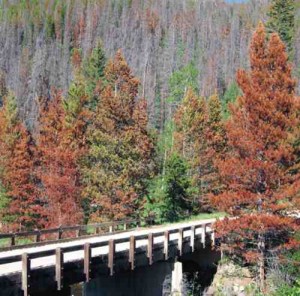Essay by Lincoln Bramwell
Wildfire – December 2007 – Colorado Central Magazine
THE RECENT WILDFIRES that burned 600 square miles, razed some 3,000 homes, killed 14 people and forced the evacuations of over a half-million Southern Californians shared one characteristic: All the homes burned were so close to public land that fire moved easily from hillsides covered with chaparral into subdivisions packed with natural vegetation.
I’ve seen fire like this before. In 2000, I was readying my fire gear with other seasonal firefighters in the Pike National Forest of Colorado’s Front Range. A spotter plane had reported a fire moving fast toward homes in a heavily forested area. But the houses were so well hidden that as we drove toward the blaze, I had to ask, “Is there really a suburb ahead?” There was, but not for long.
Before we could control it, the Hi Meadows Fire destroyed over 50 homes and was then the largest “urban interface” fire in Colorado history. Urban interface is the term the federal government uses to describe areas where houses abut public lands. Just two years later, the Hayman Fire earned the distinction of the state’s worst fire, scorching 85,000-acres and burning hundreds of homes. Regrettably, one of my former co-workers started that blaze.
I fought fires on a Hot Shot crew for the Forest Service for nine summers and loved the job, chasing fires in every state in the West. But my work changed dramatically as more people built homes among the trees. Fires that once were relatively easy to deal with became complicated and much more dangerous.
Here’s an example: In earlier years when a ridgetop fire was raging, firefighters could safely light a back burn from the bottom of the hill to meet the oncoming fire. After housing dotted the hills, we were increasingly asked to insert ourselves into the forest where fire behavior was always uncertain, and where we were expected to make heroic stands. Not surprisingly, as more pressure was put on fire crews to protect homes, more firefighters died trying. Newly married in 2002, I read the writing on the wall and quit.
I didn’t leave fire entirely behind. I’d been working toward a doctorate in environmental history and began focusing on fire’s relationship to settling the West. Wildfires like those in Southern California aren’t new; they’ve thundered down the coastal mountains for generations. But interface fires were new in the 1930s, when they began burning on the edges of Southern California’s new national forests. That’s where developers had begun to build subdivisions — I think of them as wilderburbs — on ridge tops, hillsides or valley floors. They featured large lots and retained natural vegetation to provide the illusion of solitude, yet were close to the city. They also interrupted the path of historic fire. A blaze in 1956 swept down the Santa Monica Mountains all the way to the Pacific Ocean, destroying more than 100 Malibu homes and killing one person.
The Malibu Fire 51 years ago demonstrated the problems to come. Federal fire-suppression policies produced loads of natural fuels that were ripe for a large blaze. Yet the federal government offered tax relief and soft repayment loans to burned-out homeowners to rebuild, removing responsibility from the homeowners and developers who continued to throw up homes in increasingly volatile, fire-prone areas.
WHEN THE FEDERAL GOVERNMENT finally recognized that forests could not be — or should not be — prevented from burning, it faced two major problems: the region’s increasing periods of acute drought and its irresponsible homeowners. I’ll never forget the day in Utah when I worked feverishly with two other firefighters to cut down 15-foot-tall oak brush overhanging a highly flammable shake-shingle roof. The homeowners appeared and started screaming at us not to cut down their beloved trees. Dumbfounded, we wrote that home off as a loss and moved on to try to save another structure.
By now, everyone must know that the tragedy in Southern California will repeat itself. The West is simultaneously drying and heating up while more and more people are moving into vulnerable wilderburbs. One survey estimates that 14 percent of public land boundaries are already developed. Most of the residents there probably believed at one time that their environment was safe, but it is not safe and never was. Residents have moved into forest landscapes that have evolved to the point where they are now prone to massive fires called “stand replacing.”
Take it from one former-firefighter turned historian: Visit the woods often. Just don’t build your house there.
Lincoln Bramwell is a contributor to Writers on the Range, a service of High Country News. He is a historian at the University of Nevada at Las Vegas.

